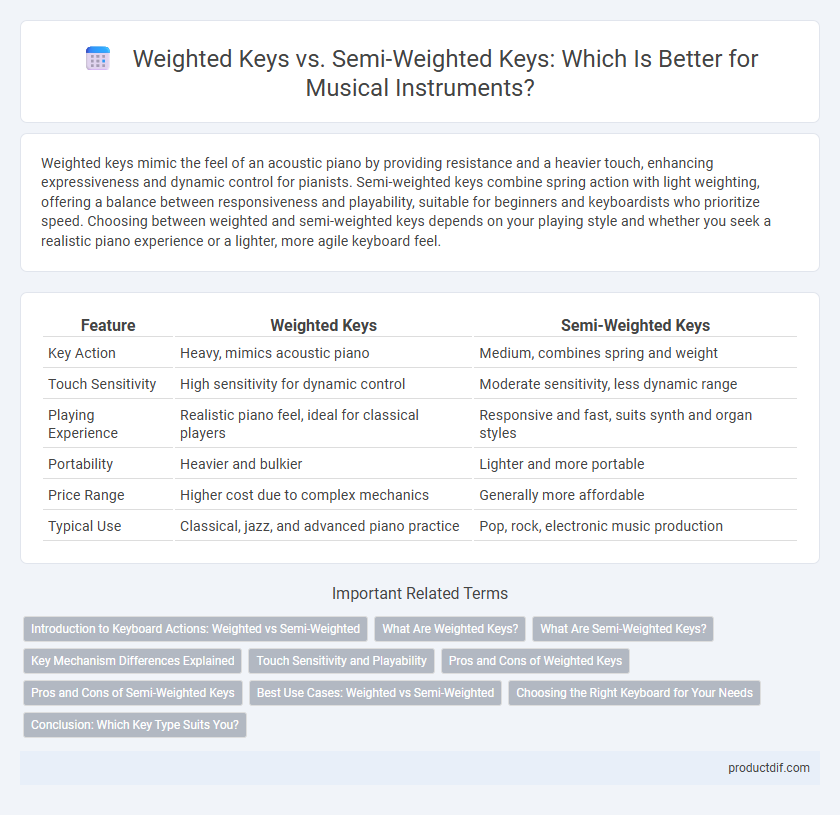Weighted keys mimic the feel of an acoustic piano by providing resistance and a heavier touch, enhancing expressiveness and dynamic control for pianists. Semi-weighted keys combine spring action with light weighting, offering a balance between responsiveness and playability, suitable for beginners and keyboardists who prioritize speed. Choosing between weighted and semi-weighted keys depends on your playing style and whether you seek a realistic piano experience or a lighter, more agile keyboard feel.
Table of Comparison
| Feature | Weighted Keys | Semi-Weighted Keys |
|---|---|---|
| Key Action | Heavy, mimics acoustic piano | Medium, combines spring and weight |
| Touch Sensitivity | High sensitivity for dynamic control | Moderate sensitivity, less dynamic range |
| Playing Experience | Realistic piano feel, ideal for classical players | Responsive and fast, suits synth and organ styles |
| Portability | Heavier and bulkier | Lighter and more portable |
| Price Range | Higher cost due to complex mechanics | Generally more affordable |
| Typical Use | Classical, jazz, and advanced piano practice | Pop, rock, electronic music production |
Introduction to Keyboard Actions: Weighted vs Semi-Weighted
Weighted keys mimic the feel of an acoustic piano by incorporating hammer mechanisms that provide resistance and dynamic response, enhancing expression and playing technique. Semi-weighted keys combine spring mechanisms with slight weighting to offer a lighter touch and faster key return, striking a balance between responsiveness and ease of play. Choosing between weighted and semi-weighted actions depends on the player's preference for realism versus agility in keyboard performance.
What Are Weighted Keys?
Weighted keys mimic the feel of an acoustic piano by incorporating heavier, hammer-like mechanisms to simulate natural key resistance and dynamic response. These keys provide a more authentic playing experience, enhancing touch sensitivity and allowing for greater expression in dynamics and articulation. Weighted keys are essential for pianists seeking realistic tactile feedback and improved control over their performance.
What Are Semi-Weighted Keys?
Semi-weighted keys combine the spring action of synth keys with added weight to simulate an authentic piano feel, offering a balance between responsiveness and subtle resistance. They feature a mechanism that provides tactile feedback, making them ideal for players who want expressive control without the full resistance of fully weighted keys. These keys are commonly found on digital keyboards and synthesizers, bridging the gap between synth-style and piano-style playing.
Key Mechanism Differences Explained
Weighted keys utilize a hammer action mechanism that mimics the resistance and feel of an acoustic piano, providing a heavier, more authentic touch response ideal for dynamic control. Semi-weighted keys combine a spring-loaded mechanism with light weights, offering a balance between the tactile feedback of weighted keys and the faster playability of synth-action keys. The key mechanism differences significantly impact performance techniques, with weighted keys favoring expressive, nuanced playing and semi-weighted keys supporting faster, more agile finger movements.
Touch Sensitivity and Playability
Weighted keys offer a heavier, piano-like touch that enhances expressive control and dynamic range, ideal for classical and jazz musicians seeking authentic playability. Semi-weighted keys combine spring action with some added resistance, providing a lighter feel that balances speed and articulation for genres like pop and rock. Touch sensitivity in weighted keys responds more accurately to varying pressure, delivering nuanced sound modulation, whereas semi-weighted keys favor faster playing but with less tactile feedback.
Pros and Cons of Weighted Keys
Weighted keys offer a piano-like feel that enhances expressive playing and improves finger strength, making them ideal for classical and advanced musicians. They provide better dynamic control and authentic touch sensitivity but can be heavier and more tiring for extended playing sessions or beginners. The added weight often increases the cost and bulkiness of the instrument, limiting portability compared to semi-weighted keys.
Pros and Cons of Semi-Weighted Keys
Semi-weighted keys offer a balanced playing experience by combining spring mechanisms with light weighting, allowing for faster repetition and greater control suitable for genres requiring agility, such as jazz or funk. They provide increased sensitivity and partial tactile feedback compared to non-weighted keys, enhancing expression without the full resistance and fatigue of fully weighted keys. However, semi-weighted keys lack the authentic hammer action feel of weighted keys, which may limit their appeal to pianists seeking a true acoustic piano touch.
Best Use Cases: Weighted vs Semi-Weighted
Weighted keys are ideal for pianists seeking authentic acoustic piano touch and dynamic control, making them perfect for classical performance and studio recording. Semi-weighted keys offer a lighter, more responsive feel suited for live gigs, synth playing, and genres requiring fast action and modulation. Choosing between weighted and semi-weighted depends on the desired expressiveness and playing style, with weighted keys enhancing realism and semi-weighted keys offering versatility and speed.
Choosing the Right Keyboard for Your Needs
Weighted keys mimic the feel of an acoustic piano by providing resistance and a heavier touch, ideal for pianists seeking authentic playing experience and improved finger strength. Semi-weighted keys combine spring action and partial weighting, offering a lighter touch suitable for beginners or those requiring faster key response for styles like synth or organ. Selecting between weighted and semi-weighted keyboards depends on playing style, skill level, and desired sound characteristics, with weighted keys favored for classical and expressive genres while semi-weighted suits versatile or electronic music applications.
Conclusion: Which Key Type Suits You?
Weighted keys offer a realistic piano feel ideal for classical pianists and those seeking authentic touch response, while semi-weighted keys provide a lighter action better suited for beginners and versatile playing styles. Consider your playing goals: prioritize weighted keys for expressive dynamics and traditional techniques, or semi-weighted for faster, more flexible performances. Choosing between weighted and semi-weighted keys depends on your musical preferences, skill level, and the genre you intend to play.
Weighted Keys vs Semi-Weighted Keys Infographic

 productdif.com
productdif.com